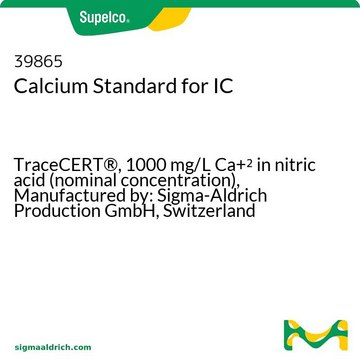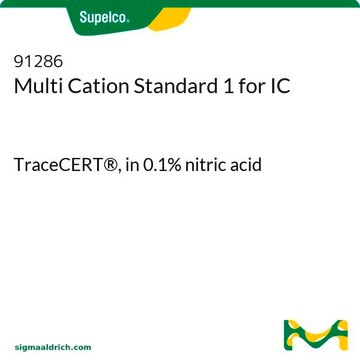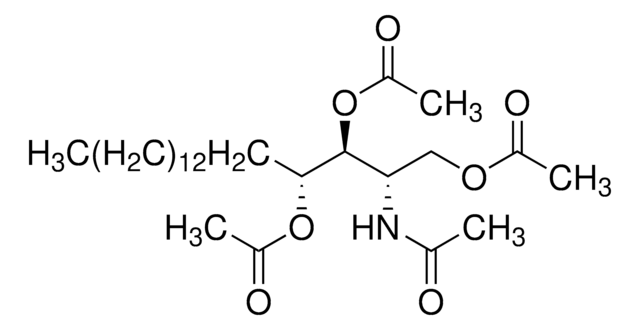Wszystkie zdjęcia(1)
Key Documents
55517
Methanesulfonic acid concentrate
0.1 M CH3SO3H in water (0.1N), eluent concentrate for IC
Synonim(y):
Methanesulfonic acid solution
Zaloguj sięWyświetlanie cen organizacyjnych i kontraktowych
About This Item
Wzór liniowy:
CH3SO3H
Numer CAS:
Masa cząsteczkowa:
96.11
Beilstein:
1446024
Numer MDL:
Kod UNSPSC:
12161700
Identyfikator substancji w PubChem:
NACRES:
NB.21
Polecane produkty
Poziom jakości
stężenie
0.1 M CH3SO3H in water (0.1N)
metody
ion chromatography: suitable
ciąg SMILES
CS(O)(=O)=O
InChI
1S/CH4O3S/c1-5(2,3)4/h1H3,(H,2,3,4)
Klucz InChI
AFVFQIVMOAPDHO-UHFFFAOYSA-N
Szukasz podobnych produktów? Odwiedź Przewodnik dotyczący porównywania produktów
Opis ogólny
This eluent concentrate for ion chromatography is determined by potentiometric titration. Content and expiry date can be found on the certificate.
Zastosowanie
- Design of a new nanocomposite based on Keggin-type [ZnW(12)O(40)](6-) anionic cluster anchored on NiZn(2)O(4) ceramics: Explores the synthesis of advanced materials using Methanesulfonic acid, contributing to developments in energy storage and catalysis technology (Rezvani et al., 2024).
- Nanosuspensions in ophthalmology: Overcoming challenges and enhancing drug delivery for eye diseases: Discusses the role of Methanesulfonic acid in the formulation of nanosuspensions, enhancing therapeutic efficiency in ophthalmologic applications (Fathi-Karkan et al., 2024).
- Building Flame-Retardant Polymer Electrolytes via Microcapsule Technology for Stable Lithium Batteries: Methanesulfonic acid may be utilized in the synthesis of flame-retardant materials for safer lithium battery technologies, addressing critical needs in electronic manufacturing (Zhang et al., 2024).
- Catalysts for C-N coupling in urea electrosynthesis under ambient conditions from carbon dioxide and nitrogenous species: Highlights the application of Methanesulfonic acid in developing catalysts for green chemistry processes, particularly in the efficient synthesis of urea from environmentally benign sources (Yang et al., 2024).
Powiązanie
Visit the IC Portal to learn more
Uwaga dotycząca przygotowania
Prepared with methanesulfonic acid and high purity water (18.2 MΩ, 0.2 μm filtered)
This page may contain text that has been machine translated.
produkt powiązany
Numer produktu
Opis
Cennik
Kod klasy składowania
12 - Non Combustible Liquids
Klasa zagrożenia wodnego (WGK)
nwg
Temperatura zapłonu (°F)
Not applicable
Temperatura zapłonu (°C)
Not applicable
Środki ochrony indywidualnej
Eyeshields, Gloves
Wybierz jedną z najnowszych wersji:
Masz już ten produkt?
Dokumenty związane z niedawno zakupionymi produktami zostały zamieszczone w Bibliotece dokumentów.
Klienci oglądali również te produkty
Chris Twelves et al.
Breast cancer research and treatment, 148(3), 553-561 (2014-11-09)
Data from two phase 3 studies of eribulin were pooled in analyses initially requested by the European Medicines Agency to assess whether specific patient subgroups, previously treated with an anthracycline and a taxane, benefited from eribulin. Study 305/EMBRACE included women
Neal W Sach et al.
Organic letters, 14(15), 3886-3889 (2012-07-18)
A general synthesis of aryl ethers from primary and secondary alcohols and aryl mesylates is presented. The reaction proceeds via a sulfonyl-transfer mechanism. In this paper, we compare the sulfonyl transfer reaction to Mitsunobu ether formation. The reaction can be
Solvejg Jørgensen et al.
Physical chemistry chemical physics : PCCP, 15(14), 5140-5150 (2013-03-02)
The gas phase reaction between methane sulfonic acid (CH3SO3H; MSA) and the hydroxyl radical (HO), without and with a water molecule, was investigated with DFT-B3LYP and CCSD(T)-F12 methods. For the bare reaction we have found two reaction mechanisms, involving proton
Norio Murai et al.
Organic letters, 14(11), 2818-2821 (2012-05-18)
A one-pot primary aminomethylation of aryl halides, triflates, mesylates, and tosylates via Suzuki-Miyaura cross-coupling reactions with sodium phthalimidomethyltrifluoroborate followed by deamidation with ethylenediamine is reported.
Cassandra J Gaston et al.
Environmental science & technology, 44(5), 1566-1572 (2010-02-04)
Dimethyl sulfide (DMS), produced by oceanic phytoplankton, is oxidized to form methanesulfonic acid (MSA) and sulfate, which influence particle chemistry and hygroscopicity. Unlike sulfate, MSA has no known anthropogenic source making it a useful tracer for ocean-derived biogenic sulfur. Despite
Nasz zespół naukowców ma doświadczenie we wszystkich obszarach badań, w tym w naukach przyrodniczych, materiałoznawstwie, syntezie chemicznej, chromatografii, analityce i wielu innych dziedzinach.
Skontaktuj się z zespołem ds. pomocy technicznej









